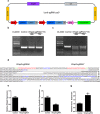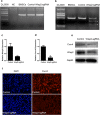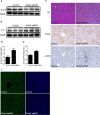Wisp2 disruption represses Cxcr4 expression and inhibits BMSCs homing to injured liver
- PMID: 29228730
- PMCID: PMC5716770
- DOI: 10.18632/oncotarget.22006
Wisp2 disruption represses Cxcr4 expression and inhibits BMSCs homing to injured liver
Abstract
Liver regeneration/repair is a compensatory regrowth following acute liver failure, and bone marrow-derived mesenchyme stem cell (BMSC) transplantation is an effective therapy that promotes liver regeneration/repair. Wnt1 inducible signaling pathway protein 2 (Wisp2) is highly expressed in BMSCs, however, its function remains unclear. In this work, we used clustered regularly interspaced short palindromic repeats (CRISPR)-associated protein -9 nuclease (CRISPR/Cas9) genome editing technology to knockdown Wisp2 in BMSCs, and these modified cells were then transplanted into rats which were induced by the 2-AAF/PH. By linking the expression of Cas9 to green fluorescent protein (GFP), we tracked BMSCs in the rats. Disruption of Wisp2 inhibited the homing of BMSCs to injured liver and aggravated liver damage as indicated by remarkably high levels of ALT and AST. Moreover, the key factor in BMSC transplantation, C-X-C chemokine receptor type 4 (Cxcr4), was down-regulated in the Wisp2 depleted BMSCs and had a lower expression in the livers of the corresponding rats. By tracing the GFP marker, more BMSCs were observed to differentiate into CD31 positive endothelial cells in the functional Wisp2 cells but less in the Wisp2 gene disrupted cells. In summary, Wisp2 promotes the homing of BMSCs through Cxcr4 related signaling during liver repair in rats.
Keywords: BMSCs; Cxcr4; Wisp2; homing; rat.
Conflict of interest statement
CONFLICTS OF INTEREST The authors declare that they have no competing interests.
Figures






Similar articles
-
Overexpression of c-Met in bone marrow mesenchymal stem cells improves their effectiveness in homing and repair of acute liver failure.Stem Cell Res Ther. 2017 Jul 5;8(1):162. doi: 10.1186/s13287-017-0614-2. Stem Cell Res Ther. 2017. PMID: 28679425 Free PMC article.
-
Bone Marrow Mesenchymal Stem Cells Reverse Liver Damage in a Carbon Tetrachloride-induced Mouse Model of Chronic Liver Injury.In Vivo. 2016 May-Jun;30(3):187-93. In Vivo. 2016. PMID: 27107074
-
SDF-1alpha/CXCR4-mediated migration of systemically transplanted bone marrow stromal cells towards ischemic brain lesion in a rat model.Brain Res. 2008 Feb 21;1195:104-12. doi: 10.1016/j.brainres.2007.11.068. Epub 2007 Dec 14. Brain Res. 2008. PMID: 18206136
-
Therapeutic applications of CRISPR RNA-guided genome editing.Brief Funct Genomics. 2017 Jan;16(1):38-45. doi: 10.1093/bfgp/elw032. Epub 2016 Aug 25. Brief Funct Genomics. 2017. PMID: 27562951 Review.
-
CCN5/WISP2 and metabolic diseases.J Cell Commun Signal. 2018 Mar;12(1):309-318. doi: 10.1007/s12079-017-0437-z. Epub 2017 Dec 15. J Cell Commun Signal. 2018. PMID: 29247377 Free PMC article. Review.
Cited by
-
Expression and biological function of the cellular communication network factor 5 (CCN5) in primary liver cells.J Cell Commun Signal. 2023 Jun;17(2):307-320. doi: 10.1007/s12079-023-00757-8. Epub 2023 May 11. J Cell Commun Signal. 2023. PMID: 37166689 Free PMC article.
References
-
- Jemal A, Bray F, Center MM, Ferlay J, Ward E, Forman D. Global cancer statistics. CA Cancer Journal for Clinicians. 2011;61:69–90. - PubMed
-
- Torre LA, Bray F, Siegel RL, Ferlay J, Lortet-Tieulent J, Jemal A. Global cancer statistics, 2012. CA Cancer Journal for Clinicians. 2015;65:87–108. - PubMed
-
- Oh SH, Witek RP, Bae SH, Zheng D, Jung Y, Piscaglia AC, Petersen BE. Bone marrow-derived hepatic oval cells differentiate into hepatocytes in 2-acetylaminofluorene/partial hepatectomy induced liver regeneration. Gastroenterology. 2007;132:1077–1087. - PubMed
LinkOut - more resources
Full Text Sources
Other Literature Sources

